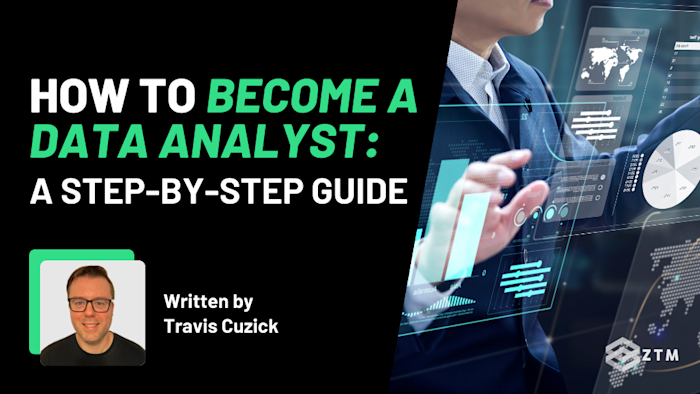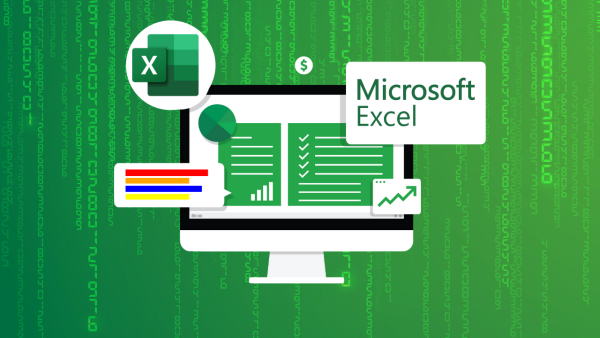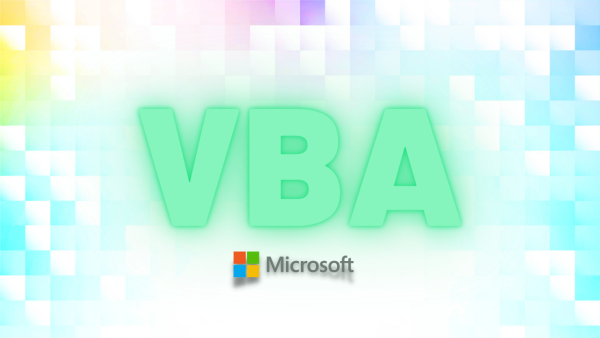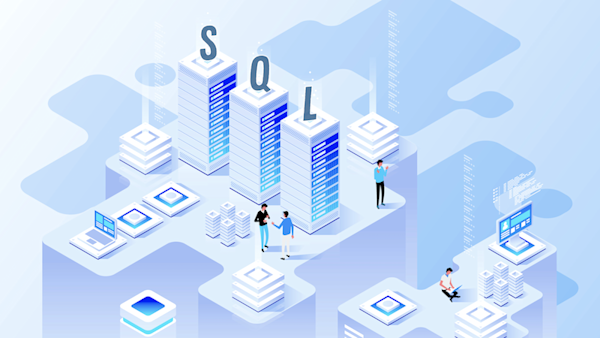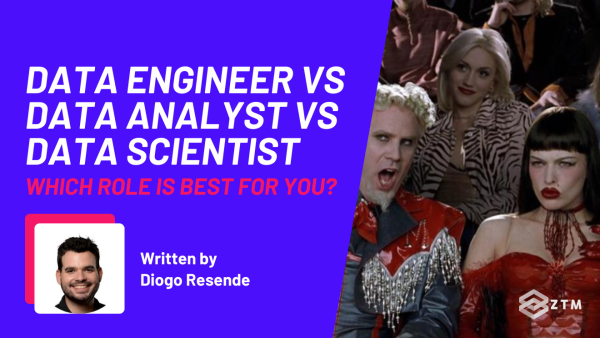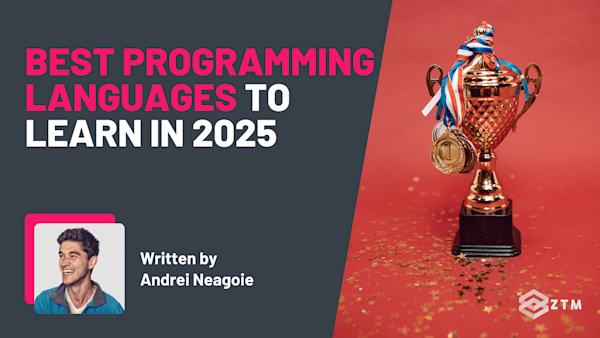Data analysis is not just a buzzword - it's a vital skill set for driving decisions in virtually every industry. From healthcare to finance, marketing to logistics, businesses rely on Data Analysts to make sense of the overwhelming amount of information at their disposal.
But what exactly does it take to become one, and is it worth it?
In this guide, I’ll pull back the curtains for you and show you exactly what it takes to become a Data Analyst and answer those important questions and more, like:
- Do you need a degree to get started or get hired? Nope!
- Are there job opportunities? Yep! Around 95,437 in the US alone
- How much does it pay? $82,640 is the average of those available jobs (with more experienced roles going as high as $130,000)
Not bad right?
Keep reading and I’ll also cover exactly what a Data Analyst does, the skills required, how to get the experience you need to land a job, as well as what you need to learn to do this role and how to learn it ASAP.
So that by the end of this guide, you can take the first steps to starting a new career!
Why listen to me?
My name is Travis Cuzick, I’m a self-taught developer and an instructor here at Zero to Mastery where I teach a wide range of data-focused courses.
I’ve also been architecting and coding data solutions for well over a decade now, for some of the biggest companies on the Fortune 500.
In my day job, I work as a Data Solutions Engineer, and use my various skills to query and manipulate multi-terabyte enterprise data stores for major U.S. financial institutions. (Both ‘big’ and important data!).
However, as a self-taught dev, I know that it can be daunting to start a brand new career, so I’ll try to keep this guide as nice and simple as I can, so you can take action and not be overwhelmed.
So let's dive in...
What does a Data Analyst do?
The data analyst role is usually the first step into a data-focused career.
In simple terms, they are responsible for collecting, processing, and analyzing data to uncover insights that can help organizations make informed decisions, as well as sometimes advising on those decisions.
They get the information, make sure it’s correct, and then give advice on what that data means and what to do next.
In more technical terms, it breaks down like this:
Data Collection
- Source Identification: Identifying and accessing data from various internal and external sources, including databases, spreadsheets, APIs, and online repositories
- Data Extraction: Extracting relevant datasets while ensuring data integrity and accuracy
- Data Integration: Combining data from multiple sources to create comprehensive datasets for analysis
Data Cleaning
- Data Validation: Checking data for errors, inconsistencies, and missing values
- Data Transformation: Converting data into a usable format and standardizing data elements
- Data Imputation: Filling in missing values or correcting errors using appropriate techniques such as mean imputation or predictive modeling
Data Analysis
- Statistical Analysis: Applying statistical methods to analyze data distributions, correlations, and significance levels
- Descriptive Analysis: Summarizing and describing key characteristics of the data using measures such as mean, median, and standard deviation
- Predictive Modeling: Building models to forecast future trends or outcomes based on historical data
- Segmentation Analysis: Identifying distinct groups within the data based on common characteristics or behaviors
Data Visualization
- Chart Creation: Generating visual representations of data using charts, graphs, and diagrams
- Dashboard Development: Designing interactive dashboards to visualize key performance indicators and trends
- Data Storytelling: Using visualizations to communicate insights effectively and engage stakeholders
Report Generation
- Insight Synthesis: Summarizing analysis findings and extracting actionable insights from data
- Report Writing: Creating comprehensive reports or presentations to convey analysis results to stakeholders
- Recommendation Formulation: Formulating recommendations based on data analysis to support strategic decision-making
Decision Support
- Strategic Guidance: Providing data-driven recommendations to assist in strategic planning and decision-making processes
- Performance Monitoring: Monitoring key metrics and performance indicators to assess the effectiveness of business strategies
- Scenario Analysis: Conducting scenario analysis to evaluate the potential impact of different decisions or events on business outcomes
Continuous Improvement
- Methodology Enhancement: Continuously refining data analysis techniques and methodologies to improve accuracy and efficiency
- Tool Evaluation: Exploring new tools and technologies to enhance data analysis capabilities
- Feedback Incorporation: Incorporating feedback from stakeholders to enhance the relevance and usefulness of analysis outputs
TL;DR
Data analysts play a crucial role in transforming raw data into meaningful information that drives business growth and innovation.
As the saying goes... "garbage in, garbage out". If the data isn't clean and reliable, the insights and models that rely on that data are virutally useless or at worst, they could lead to costly mistakes.
Is Data Analysis a good career choice?
It sure is!
The global Big Data and Data Analytics Services market size is expected to expand at a CAGR of 16%, reaching $290.36 billion by 2028!

So yeah, it’s safe to say that the industry is growing.
And as for jobs? There are currently 95,437 Data Analyst jobs available in the US right now on ZipRecruiter.
How much do Data Analysts get paid?
If we look at the average salary of those jobs available above, it's $82,640 per year, with some as high as $130,000.

It’s not as high as some more experienced careers in Data, but $80,000+ is great for entry level.
This is a great place to start out. From here, you can always continue to advance your skills and get more experience to land more senior roles (more on that later).
Also, because Data Analysis pretty much just needs a computer and the internet, a lot of those jobs offer remote work also, which is another great perk!
Do I need a degree to become a Data Analyst?
Nope! Some big tech companies may ask for a Math, CS or similar degree, but the majority of them don’t care. All they want to know is that you can do the job, and have a portfolio of work to prove it.
However, you will need to understand and know how to use statistics, but I'll share some training on this in a second, as well as how to create that portfolio to get hired.
In the meantime though, let’s take a quick look at what other skills you’ll need.
What skills do I need to become a Data Analyst?
Becoming a data analyst requires a combination of technical skills, analytical abilities, and domain knowledge.
For the sake of completion, let’s cover all of these quickly below:
Technical Skills
- Data Manipulation: You need to be proficient in the SQL programming language for querying databases and data manipulation tasks
- Programming Languages: As well as SQL, you also need to learn Python or R for data analysis, manipulation, and visualization
- Data Visualization: Ability to create clear and effective visualizations using tools like Matplotlib, Seaborn, ggplot2, or Tableau. That being said, you basically feed the data into these tools and then select the graph options, so it’s much easier than it sounds
- Statistical Analysis: Understanding of statistical concepts and techniques for data analysis, hypothesis testing, and regression analysis. This is vital, as you need to understand what all those numbers mean
- Machine Learning: Although not always required at entry level, it can’t hurt to get familiar with with machine learning algorithms and techniques for predictive modeling, classification, and clustering - especially if you want to advance to a Data Scientist role later on
- Data Wrangling: Experience in data cleaning, preprocessing, and transformation using libraries like Pandas or dplyr. Basically, making sure the data is usable
Analytical Skills
- Critical Thinking: Ability to think analytically, identify patterns, and draw insights from data. What do these numbers mean?
- Problem-Solving: Ability to frame business problems, formulate hypotheses, and develop analytical solutions. What actions should be taken?
- Attention to Detail: Thoroughness in data analysis and attention to detail to ensure accuracy and reliability of results. Can you trust these numbers are correct?
- Quantitative Analysis: Strong numerical and quantitative skills for analyzing and interpreting data
Domain Knowledge
- Industry Knowledge: Understanding of the industry or domain in which you work, including key metrics, trends, and challenges
- Business Acumen: Ability to understand business requirements, translate them into analytical tasks, and provide actionable insights
- Data Governance: Knowledge of data governance principles, data privacy regulations, and best practices for data management
Soft Skills
- Communication: Effective communication skills to articulate findings, present insights, and interact with stakeholders
- Collaboration: Ability to work collaboratively in interdisciplinary teams and communicate effectively with colleagues from diverse backgrounds
- Adaptability: Willingness to learn new tools and techniques, adapt to changing requirements, and stay updated with industry trends
- Time Management: Strong organizational skills and the ability to prioritize tasks to meet deadlines and deliver results efficiently
Tl;DR
- Can you use the tools to acquire the data?
- Can you analyze it and understand what it means, and recommend the best actions to take?
- Do you understand the current business and how that data relates to it?
- Do you have the communication skills to present that?
How long does it take to become a Data Analyst?
The average time for some to fully complete our Data Analyst career path is around 7 months.
Bear in mind, this will vary based on how much time you can spend learning per week, how fast you learn, etc.
7 months may seem like a long time, but this will give you all of the skills you need to get hired in this role ASAP - even if you’re starting from scratch. If you already have some experience, you may even speed this up further.
Also, 7 months isn’t that long in the grand scheme of things, especially when you’re starting out on a brand new career!
How to become a Data Analyst (Without a degree and with no experience!)
Alright here we go! Each step in this roadmap will teach you the required technical skills to secure the Data Analyst role that we covered earlier (as well as a few more).
Important: The 2nd and 3rd steps in this roadmap are where you’ll be spending the bulk of your time, and there are a lot of topics to learn.
That being said, you could definitely start applying for Junior Data Analyst roles after step 2 and get hired, and then continue to learn the skills from step 3 and 7, if you so wished.
So although this guide is long and there are a lot of skills, you can actually start working much earlier than you think, and then get paid while you continue to learn!
Not bad right?
With that out of the way, let’s take a look at these steps, along with resources where possible.
Step 1. Set yourself up for success
This first step is completely optional but highly recommended, because here’s the thing: Most people don’t know how to learn effectively.
It’s not their fault. Schools teach basic rote methods of learning which are pretty inefficient. They say the thing, and you try to remember the thing, and it's not great - especially if you require certain learning styles to learn best.
This means that topics you might do well with are harder to remember or apply, so it takes longer to learn.
Math and statistics are a great example of this, because it’s very hard to grasp Math concepts without actually applying them and trying to solve problems right?
We call this applied learning. You’re taking what you learn and using it so you can remember and comprehend it better. The thing is, there are multiple different learning techniques just like this that you can use that make all of your future learning efforts far more effective.
This means you can understand faster and more efficiently, so less back and forth.
You can learn a lot of the key techniques for free right now in this guide, or better still, learn and practice every important technique inside of Andrei Neagoie's learning how to learn course.
Estimated Time Required For This Step: 5 days.
I know it might feel like a step backward or even a detour, but think about it like this:
- You can learn the core principles in a few days and then immediately start putting them into practice
- You're going to learn everything else on this list (as well as anything in the future) 2x faster and retain way more as well
- This is a skill that you can keep developing over time and will serve you for your entire career, guaranteed
Bear in mind that there are multiple skills that you need to pick up to become a Data Analyst, and each of them can take weeks or even months of work to complete.
So why not learn how to cut down on that time, improve your comprehension, and pick up skills faster and easier first? The time and energy savings will seriously compound as you go through the rest of the content you need to learn.
Then, once you’ve gone through that course and figured out how to learn faster, you can jump into learning everything else that you need to know to become a Data Analyst at a more accelerated pace.
Step 2. Build a solid math and coding foundation
Alright, let’s get into actual data analysis training now.
These first 2 resources are the core of what you need for this career, and are going to take a lot of time to complete. That being said, you can definitely apply for Junior Data Analyst roles right after this, and then continue to learn the other skills.
Start by learning statistics with Python
As you might guess, this course is not only going to teach you statistics, but it will also teach you the basics of the Python programming language, as well as how to use Python to perform statistical analysis.
No prior experience is required in either coding or even a math background, as you learn everything from scratch.
Estimated Time Required: 42 days.
That being said, the course videos are around 25 hours in total, and include 6 projects to apply and practice (and add to a portfolio later).
You may get these done faster, but 42 days is the average for our students.
Learn Business Analytics with Python
Now that you understand statistics and have the basics of Python, it’s time to learn Business Analytics (aka the field you’re training to be in).
This course will walk you through how to get started with this career, give you the core skills, show you how to analyze and visualize data, how to run tests, will further improve your Python skills for data analysis, and much more!
Estimated Time Required: 20 days.
So, if we add those both up, you’re looking at around 2 months (62 days total) to understand the most important aspects for becoming a Data Analyst.
Not bad right!? At this point, you can definitely start looking for Junior Data Analyst roles and apply if you want to.
Yes, you will need to continue to learn the skills in the next step to understand everything for this role. However, you’ll be surprised how many will hire you already with what you know so far. (Especially if you completed the project work from each of these courses).
Step 3. Learn additional Data Analysis tools
Now that you have the core skills under your belt, let’s look at some other common tools and more advanced Data Analysis skills that can help fast-track you to more senior positions and higher salaries.
Be warned though. This is where you’ll spend the bulk of your time, so be prepared to buckle in.
Learn how to use Excel for Basic Data Analysis
I know what you’re thinking… Why learn Excel? Isn’t this about becoming a full fledged Data Analyst?
That’s correct, however the fact of the matter is, that literally millions of companies around the world use Excel, so you need to learn how to use it effectively for Data Analysis.
That’s why we have 3 different resources that you need to learn. This first one will teach you the fundamentals of Excel for Data Analysis, including formulas, macros and more. Again, zero experience required.
Estimated Time Required: 34 days.
Learn Advanced Excel for Data Analytics and Business Intelligence
Now that you have the basics covered, it’s time to dive into more advanced Excel features and skills.
Commonly referred to as Excel’s ‘power’ suite of tools, you’ll learn Power Query, Power Pivot Tables, the DAX formula language, data modeling and more.
Not only that, but you’ll get to apply these across a real-life project to see how they work. (You will need to have covered the previous Excel course to understand this one).
Estimated Time Required: 15 days.
Learn VBA for further Excel Data Analysis
Time to learn another programming language!
VBA, or Visual Basic for Applications is a programming language developed by Microsoft that is integrated into Microsoft Office applications such as Excel, Word, PowerPoint, and Access.
VBA allows you to automate tasks and create custom functionality within these Office applications, and as you might have guessed, this is great when we’re using Excel for Data Analysis.
Any time you can create a one click automation for a repeatable task that will save you literally hours and hours of time per year, is worth its weight in gold!
You’ll not only learn how to streamline and automate your Data Analyst tasks, but you’ll also learn further tips and tricks to enhance your current skills.
Estimated Time Required: 14 days.
Learn SQL + Databases
Another new programming language, and the last on this list.
SQL is the standard language for interacting with relational databases, and as a data analyst, you'll often need to extract data from said databases to perform analysis.
SQL also allows you to write queries to retrieve specific data sets based on your requirements, as well as provides powerful tools for manipulating data within databases, such as filtering, sorting, aggregating, and transforming data before analyzing it further.
This ability is essential for preparing data for analysis and generating meaningful insights. You can also use it for data validation and quality checks within databases, making it a key component of a robust data quality framework.
Estimated Time Required: 45 days.
Bonus! You can check out the first 8 hours of this SQL course in the video below for free:
Learn Time Series Forecasting with Python
Time series forecasting is a method used to predict future values based on historical data points that are ordered over time.
In simple terms, it's about making educated guesses about what will happen in the future by analyzing patterns and trends in past data.
This means you can use it for things such as predictive analytics, risk management, and performance evaluations. Everything you need to make data-driven business decisions.
Estimated Time Required: 25 days.
Learn Power BI
The last tool to learn until you’re a fully fledged and professional Data Analyst!
Power BI is a robust data visualization and analysis tool that helps Data Analysts to make sense of complex datasets through interactive reports and dashboards.
Basically, you can connect it to various data sources, integrate disparate datasets, and then create some awesome visualizations to help present and explain your data.
Estimated Time Required: 25 days.
TL;DR
Phew! You got through it all.
Like I said up top, this is the biggest step, but it also gives you the expanded suite of tools and skills you need to get hired as a Data Analyst, and possibly skip the junior positions.
Total combined time to completed everything I've outlined here will be 4-6 months.
Step 4. Get job ready
If you haven’t already, it’s time to start thinking about applying for jobs.
Before that though, let’s do 3 quick things to help you make the best first impression that you can:
-
Make sure that your LinkedIn profile looks professional and up to date. Even if you don't use the platform to apply for jobs, potential employers may look there to check you out. Not to mention, you can even get approached by headhunters and get job offers without you even applying! Be sure to add all your new skills and certifications
-
Create a one-page resume for applications. Although it won't get you the job, you're going to have to submit one when you apply, so get one made and just make sure it follows some basic best practices (there's lots of good resources and templates out there... including one I link to below)
-
Create a portfolio of your project work. Companies are going to want proof that you can do the work required, so it’s important to have a portfolio of projects you’ve completed
The good news?
Fellow ZTM instructor Dan Schifano goes through each of these elements in detail in his course on personal branding, including how to set up a professional portfolio that stands out amongst your peers. (As well as some other great tips to help you stand out even further).
Estimated Time Required For This Step: Actually building your portfolio site, writing your resume, etc (i.e. the stuff Dan Schifano covers in his branding course) should only take you 1-2 weeks to set-up and prepare.
Go ahead and build your portfolio and then add your programming projects from step 2 and 3 into it. Then, let’s look at adding some more specific Data Analyst type projects to it.
Sidenote: In other tech focused careers, I would normally advise to also gain some further experience and work on some further projects to improve your portfolio.
However, companies are not looking for analysts with out of the box ideas. They’re looking for people who can apply the skills and have experience with each important tool, so as long as you completed the projects in each course, and then add them to your portfolio, you should have enough to get hired.
That being said, you can always do more practice projects if you simply want to polish your skills and stand out a little further, but it’s not always needed to get the job.
Step 5. Apply for jobs
Now it's time to apply for those Data Analyst jobs and get hired!
Trust me, you'll never feel 100% ready but if you've followed along so far, you are ready to start working in the real-world.
If you're anxious then understand this: The simple truth is that you don't need to know every detail about everything to get hired. In fact, you'll pick up a lot of skills and experience simply by doing the job. It's about having the requirements to get started, and you already have that so start applying already!
We have an entire guide on applying for roles in the tech industry, as well as guides on specific Data Analyst interview questions + answers.
Also, if you're a ZTM member, then I HIGHLY recommend you check our Andrei's new course on getting hired at your dream job:
Estimated Time Required For This Step: 12 days.
He covers all this in far more detail, including his technique to get a 90% interview success rate!
If you're not a ZTM member, then check out this guide, as well as these extra tips:
But just because we like to spoil you, here are a few extra tips also:
Tech jobs are more than just tech skills
In addition to the technical know-how that you’ve built up through courses and certifications, interviewers will be evaluating your soft skills.
- Be prepared with examples showing how you’ve collaborated with co-workers or led teams or projects in the past
- Be able to explain the decisions you made for the projects in your portfolio and discuss various trade-offs that you made
- Make sure to demonstrate strong communication skills in writing and during the interviews (whether virtual or in-person)... Even very basic things like using proper grammar and having no spelling mistakes, sending a thank you email within 24 hours of your interview, etc.
Have specific examples of how you’ve solved problems
A Data Analyst does a lot of analysis and problem-solving during their normal work, but be prepared to talk through a situation or two where you saved the day by solving a complex or business-critical problem.
If you don’t have work-related examples, share stories from school or community projects.
The usual interview prep
Like any other kind of interview, it’s always good to:
- Research the company. Learn what you can about their Data Analysis needs and why they’re hiring for your role
- Learn what you can about the people you’ll be interviewing with, and what their potential areas of focus will be. You can always ask when they offer the interview, and they will happily let you know
- Practice, practice, practice. Do a mock interview with friends or family, or even just interview yourself, speaking your answers out loud. It’s amazing the difference this makes, and how much more polished you’ll be on the big day
- Be on time (or even a little bit early) for the interview
- Dress the part. Figure out the “norm” for the company’s culture (jeans and T-shirt or more professional?) and dress to fit in. If you’re unsure, err on the side of dressing “up"
- Prepare 2-4 questions to ask the interviewer. 99% of the time, the interviewer will give you time to ask any questions you have. Curiosity is one of the #1 traits that these employers are looking for. They want to see you have genuine interest and curiosity in their company, their team, their role, their work, etc. The worst is not having any questions at all, so make sure you have questions ready
Do all this, and you’ll smash the interview and get the job.
Estimated Time Required For This Step: Usually somewhere between 1-6 months given all the potential factors, multiple applications, time to hear back, etc.
Step 6. Continue to skill up
By this point now, you should be hired and working away in your new career.
Let’s not just stop there though. Here are 2 more tips that you can use to continue to skill up further.
1. Learn to use A.I. tools to make your life easier
Although you don't have to do this, I highly recommend that you learn to use AI tools to supplement what you do already in some way.
You don't need to work solely with A.I. to see the benefit, nor do you even need to apply it to your core tasks. But by learning to use these tools, you can increase your output and perform repeatable tasks in minutes vs hours or days - similar to what you were doing with macros and scripts, but applicable outside of data tools.
And sure - the tools are not perfect. You still need to have the core knowledge that you've learned above, but by then applying that experience you have now, with that automation, you'll not only make your life easier - but even grow in demand.
A.I. won't steal your job. But people who can do their job faster and more effectively because they can use the tools, are going to be in high demand.
So add it to your skills, make work easier, and be the one that employers fight over!
We have a few courses on this that you can check out:
Check those out and see how they might be able to help you.
Also, depending on the time that you read this, there may be new specific A.I. tools for your role, so have a quick Google search and see if there is anything that can help, and play around with it.
2. Look towards the future
You already have a lot of skills to work towards becoming a more senior Data Analyst.
What might surprise you though, is that you also have a lot of the core skills (bar a few) for even more advanced roles that pay considerably more.
I know you’ve just learned a lot, and you don’t need to do this right away.
However, continuous improvement is one of the core aspects of the highest performers in tech, and why people can start in seemingly unconnected roles, and then get $300,000+ a year job offers from Google and other companies.
So what are you waiting for? Get started today!
So there you have it - the entire roadmap to becoming a Data Analyst within the next 12 months, or sooner.
Data Analysis is a fantastic career to get into right now, with high demand, a great starting salary, and interesting topics to learn.
It’s not easy, as you do have to do the work to pick up these skills, but it’s definitely worth it, and is the perfect jumping in point for a Data focused career.
Simply follow this guide, learn what I recommend, do the work, and get hired! That’s all there is to it. You’ve got this!
P.S.
Every course that I’ve mentioned in this guide, is available with any ZTM membership:
- Learning to Learn
- Statistics with Python
- Business Data Analytics with Python
- Excel for Basic Data Analysis
- Advanced Excel for Data Analytics and Business Intelligence
- VBA for further Excel Data Analysis
- SQL + Databases
- Power BI
- Personal branding and portfolio creation
- An introduction to LLMs and ChatGPT
- Prompt Engineering with LLMs
All of these and more are all part of the Zero To Mastery Academy.
This means that if you become a member, then you have access to all of these courses right away and will have everything you need in one place, for a single membership.
Plus, as part of your membership, you'll get to join me and 1,000s of other people (some who are alumni mentors and others who are taking the same courses that you will be) in the ZTM Discord.
Ask questions, help others, or just network with other Data Analysts, Scientists, Engineers and other tech professionals.
Make today the day you take a chance on YOU. There's no reason why you couldn't be applying for Data Analyst jobs just 6-12 months from now if you just follow the steps I outlined and put in the hard work.
So what are you waiting for 😀? Come join me and get started on becoming a Data Analyst today!
